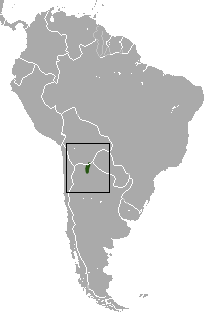Yepes's mulita or the Yungas lesser long-nosed armadillo (Dasypus mazzai) is a species of armadillo in the family Dasypodidae. It is endemic to Argentina and Bolivia. Its natural habitat is subtropical dry forests.[2] The species was renamed D. yepesi because the type of D. mazzai was suspected to correspond of other species of Dasypus, which it was later proved wrong, becoming D. yepesi a synonym of D. mazzai.[3][4][5]
| Yepes's mulita[1] | |
|---|---|

| |
| Scientific classification | |
| Domain: | Eukaryota |
| Kingdom: | Animalia |
| Phylum: | Chordata |
| Class: | Mammalia |
| Order: | Cingulata |
| Family: | Dasypodidae |
| Genus: | Dasypus |
| Species: | D. mazzai
|
| Binomial name | |
| Dasypus mazzai José Yepes, 1933
| |

| |
| Yepes's mulita range | |
| Synonyms | |
|
Dasypus yepesi | |
Geographic range
editYepes's mulita is found in the Jujuy and Salta provinces of Argentina, however its range may extend to parts of Bolivia and Paraguay. Due to the lack of data on the species, no more than nine populations are known. It is mostly found in altitudes of 450-1800m (1476 ft - 5905 ft). Its habitat ranges from deserts to humid forests.[6]
Use and trade
editThe species is known to be hunted locally for food.[6]
Conservation
editBecause so little is known about Yepes's mulita, it is listed as "Data Deficient" by the IUCN. There is ongoing deforestation in its range and its habitat is considered fragmented, which adds to the conservation concerns.[7] The species has been designated for protection in Parque Nacional Calilegua and Parque Nacional El Rey in northern Argentina.[6]
References
edit- ^ Gardner, A.L. (2005). "Order Cingulata". In Wilson, D.E.; Reeder, D.M (eds.). Mammal Species of the World: A Taxonomic and Geographic Reference (3rd ed.). Johns Hopkins University Press. p. 95. ISBN 978-0-8018-8221-0. OCLC 62265494.
- ^ a b Abba, A.M. & Vizcaíno, S. (2014). "Dasypus yepesi". IUCN Red List of Threatened Species. 2014: e.T61924A47444043. doi:10.2305/IUCN.UK.2014-1.RLTS.T61924A47444043.en. Retrieved 16 December 2019.
- ^ Teta, Pablo Vicente; Abba, Agustin Manuel; Cassini, Guillermo Hernán; Flores, David Alfredo; Galliari, Carlos Alberto; Lucero, Sergio; Ramirez, Mariano Andres (2018). "Lista revisada de los mamíferos de Argentina". Mastozoología Neotropical. 25: 163–198. doi:10.31687/saremMN.18.25.1.0.15. hdl:11336/86151. ISSN 0327-9383.
- ^ Abba, Agustín M.; Tognelli, Marcelo F.; Seitz, Viviana P.; Bender, J. Benjamín; Vizcaíno, Sergio F. (2012-05-01). "Distribution of extant xenarthrans (Mammalia: Xenarthra) in Argentina using species distribution models". Mammalia. 76 (2): 123–136. doi:10.1515/mammalia-2011-0089. hdl:11336/81154. ISSN 1864-1547. S2CID 84391812.
- ^ Feijó, Anderson; Cordeiro-Estrela, Pedro (2014-11-21). "The correct name of the endemic Dasypus (Cingulata: Dasypodidae) from northwestern Argentina". Zootaxa. 3887 (1): 88–94. doi:10.11646/zootaxa.3887.1.6. ISSN 1175-5334. PMID 25543926.
- ^ a b c Abba, A.M.; Vizcaíno, S. (2014). "Dasypus yepesi". IUCN Red List of Threatened Species. 2014: e.T61924A47444043. doi:10.2305/IUCN.UK.2014-1.RLTS.T61924A47444043.en. Retrieved 11 November 2021.
- ^ Vizcaino, S.F. & Abba, A.M. (2010). "Edentata" (PDF). Edentata. 11: 168.
